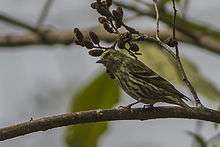Tibetan serin
| Tibetan serin | |
|---|---|
 | |
| Female Tibetan serin from Varsey Rhododendron Sanctuary, Sikkim, India. | |
| Scientific classification | |
| Kingdom: | Animalia |
| Phylum: | Chordata |
| Class: | Aves |
| Order: | Passeriformes |
| Family: | Fringillidae |
| Subfamily: | Carduelinae |
| Genus: | Spinus Koch, 1816 |
| Species: | S. thibetanus |
| Binomial name | |
| Spinus thibetanus (Hume, 1872) | |
The Tibetan serin (Spinus thibetanus) or Tibetan siskin, is a true finch species (family Fringillidae).
Taxonomy and systematics
The Tibetan serin was formerly placed in the genus Serinus but was assigned to the genus Spinus based on a phylogenetic analysis of mitochondrial and nuclear DNA sequences.[2][3]

The first description of the species was by the British ornithologist Allan Octavian Hume in 1872 under the binomial name Chrysomitris thibetanus.[4]
Description
Length (including tail) of this species is around 12 cm (4.7 in). Tibetan siskin lacks yellow panels on wing in all plumages. Adult male has olive-greenish upperparts, yellow underparts, yellowish-green rump, yellow supercilium and border behind ear-coverts. Wing and tail feather of this bird species are broadly differentiated by yellowish-green color. While females of this species has black streaking on darker greyish-green upperparts, more clearly defined wing-bars than their male counterparts, paler yellowish throat and black flanked breast with streaking. Juveniles are duller green, tinged brownish-buff on upperparts, with duller rump, buff fringes to greater coverts and paler or heavily streaked underparts.
Distribution
Country wise it is found in Bhutan, China, India, Myanmar, and Nepal. Its natural habitat is temperate forests. In winters this species spent in central and eastern Himalaya. A group of birders from West Bengal found its presence in Hee Village near Varsey Rhododendron Sanctuary, Sikkim, India in the month of March 2013.
Habitat
Tibetan serin generally breed in mixed forest and spend their winter in alder.
Voice
Their soft chattering sound is much like twang twang.
References
- ↑ BirdLife International (2012). "Serinus thibetanus". IUCN Red List of Threatened Species. Version 2012.1. International Union for Conservation of Nature. Retrieved 8 October 2016.
- ↑ Gill, Frank; Donsker, David (eds.). "Finches, euphonias". World Bird List Version 5.2. International Ornithologists' Union. Retrieved 5 June 2015.
- ↑ Zuccon, Dario; Prŷs-Jones, Robert; Rasmussen, Pamela C.; Ericson, Per G.P. (2012). "The phylogenetic relationships and generic limits of finches (Fringillidae)" (PDF). Molecular Phylogenetics and Evolution. 62 (2): 581–596. doi:10.1016/j.ympev.2011.10.002.
- ↑ Hume, Allan Octavian (1872). "Description of six new species of Indian birds". Ibis. 3rd series. 2: 107. doi:10.1111/j.1474-919x.1872.tb06136.x.
